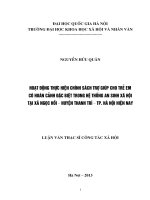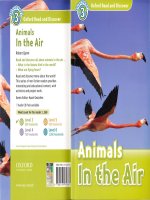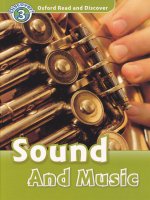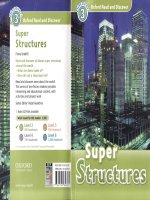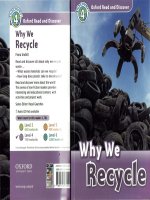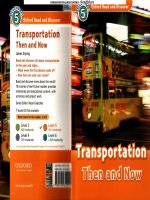Bộ sách “Oxford Read and Discover” cho trẻ em. Incredible earth
Bạn đang xem bản rút gọn của tài liệu. Xem và tải ngay bản đầy đủ của tài liệu tại đây (88.75 KB, 1 trang )
4
Incredible Earth
Pages 28–29 1 1 mountain 2 waterfall 3 rainforest 4 river 2 1 South
America 2 hard 3 mountains 4 through 5 anaconda 3 1 kilometer
2 rock 3 snake 4 mountain 5 Amazon 4 1 ocean 2 Amazon 3 rainforest
4 Brazil 5 Iguazu Falls 6 anaconda 5 1 The water in rivers comes
from rain or snow. 2 When a river goes over rocks, it makes waterfalls
AND/OR rapids. 3 Iguazu Falls is a South American waterfall. 4 The
Amazon begins in the mountains in Peru. 5 The Amazon goes
through a big rainforest. 6 You can find snakes in the Amazon.
Pages 30–31 1 1 glacier 2 mountain 3 slowly 4 icebergs 5 ice
6 incredible 2 Hot: Amazon Rainforest, coral reef, volcano, melted
rock; Cold: glacier, ice, iceberg, snow 3 1 Glaciers move very slowly.
2 Glaciers are rivers made of ice. 3 Icebergs are dangerous for boats.
4 Ilulissat is one of the coldest places. 4 1 When do glaciers begin?
They begin when snow falls. 2 What are glaciers made of? They are
made of ice. 3 Why are icebergs dangerous? Because most of the
ice is under the water. 4 Where is Ilulissat? It’s near the North Pole.
5 How long is the glacier at Ilulissat? It’s about 40 kilometers long.
Pages 32–33 1 1 rain 2 snow 3 geyser 4 pool 5 steam 6 waterfall
2 1 true 2 false 3 false 4 false 5 true 6 true 3 1 Under a geyser there
is a lot of hot rock. 2 Geysers make a loud noise. 3 The water in a
geyser is very hot. 4 Don’t go near a geyser. 5 The cliffs at Pamukkale
look like waterfalls. 6 Pamukkale is in Turkey. 4 1 Deep under the
ground, there is hot rock. 2 When water boils, it makes steam.
3 The monkeys at Jigokudani sit in the warm water. 4 In the water
there are minerals. 5 The cliffs at Pamukkale look like waterfalls.
6 Don’t go near geysers because they are very hot.
Pages 34–35 1 1 mountain chain 2 moved 3 slowly 4 highest 5 deepest
6 rivers 2 1 water 2 rainforest 3 mountain 4 top 5 very 6 Earth
3 1 What is the highest mountain in the world? Mount Everest.
2 What is the deepest lake in the world? Lake Baikal. 3 What is the
biggest mountain chain in the world? The Himalayas. 4 What is the
biggest river in the world? The Amazon. 4 free answers
Pages 36–37 1 1 near 2 move 3 caves 4 Borneo 5 rock 6 pictures
2 1 Caves are usually wet. 2 Limestone is a soft rock. 3 There are
often caves in limestone. 4 People drew pictures on cave walls.
5 Now most people don’t live in caves. 3 1 Where is the Sarawak
Chamber? It’s in Borneo. 2 Is limestone very hard? No, it’s soft.
3 Are caves usually wet? Yes, they are. 4 What are stalactites made of?
They are made of rock. 5 Why did people draw on cave walls? Because
they didn’t have books or paper. 6 Do you like caves? free answer
Pages 38–39 1 1 earthquake 2 flood 3 building 4 tsunami 5 tree 6 wave
7 house 8 ocean 2 1 moves 2 buildings 3 under 4 ocean 5 in 3 1 false
2 true 3 true 4 false 5 true 6 false 4 1 Earth’s crust moves a few
millimetres every year. 2 Big earthquakes are very dangerous.
3 Earthquakes under the ocean sometimes make tsunamis. 4 A
tsunami is a giant wave. 5 After a tsunami, there are often floods.
Pages 40–41 1 1 sand 2 stones 3 salt 4 rocks 5 rain 6 lake 7 desert
8 ground 2 1 Some deserts are made of sand. 2 It doesn’t rain
often in Antarctica. 3 The Sahara Desert is bigger than Australia.
4 Animals in the desert don’t drink very often. 5 In Bolivia, there is a
desert made of salt. 6 The Salar de Uyuni is an incredible place.
3 1 Deserts are usually hot. 2 Deserts are very dry places. 3 The Sahara
Desert is in Africa. 4 It’s very cold in Antarctica. 5 Many people visit
the Salar de Uyuni. 4 1 How much of the land on Earth is desert?
About 20 percent. 2 What is the biggest hot desert on Earth? The
Sahara Desert. 3 Where is Bolivia? In South America. 4 Why do many
people visit the Salar de Uyuni? Because it’s an incredible place.
Pages 42–43 1 1 Where is Cappadocia? It’s in Turkey. 2 What changed
the rocks in Cappadocia? The wind changed them. 3 Where is the
Grand Canyon? It’s in the USA. 4 What is the name of the river in the
Grand Canyon? It’s called the Colorado River. 5 When did erosion
begin in the Colorado River? About 20 million years ago. 2 1 water
2 earthquakes 3 desert 4 caves 5 volcano 6 Australia 7 lake 8 glacier
9 geyser 10 ocean 3 free answer
Subject Area
The Natural World
Topics & Curriculum Links
environments around the world (Geography)
places and countries (Geography)
sizes and measurements (Mathematics)
dates and events (History)
physical processes (Geography)
animals (Science)
dangers from the environment (Geography; Civics)
Vocabulary
places; materials; animals; weather; transportation;
numbers; measurements; countries; continents
Grammar
present simple; present continuous; past simple; question
forms; adjectives; prepositions; adverbs
Teaching Ideas
See also pages 6–7 for general ideas that you can adapt.
Or go to www.oup.com/elt/teacher/readanddiscover
Incredible Places Around the World
After completing Project 2, students do research, using
books or the Internet, about incredible places in another
country, or about a type of place. They display their findings
on a poster with pictures, maps, charts, etc. Students can
write about their places like this: This is [Name] ... It’s a [type of
place] ... It’s in [Country] ... It’s incredible because ... Students
can work in groups, and posters can then be displayed
together.
READ
& TALK An Incredible Tour
Using the information from the Reader and/or information
from books or the Internet, students plan a tour of five or
ten incredible places around the world. They can use a
copy of the world map on page 7 to show their tour. They
can write and talk about it like this: First, we’re going to visit
... in ... It’s a ... We’re going to see ... Then ... Next ... After that ...
Finally ... Then they can present their tour to the rest of
the class, or all the tours can be displayed together. Then
students can vote for the best tour.
Activities Answers
Pages 24–25 1 1 Earth is round. 2 Earth’s crust is millions of years old.
3 The pieces of Earth’s crust move very slowly. 4 There are different
rocks in Earth’s crust. 5 Under Earth’s crust, there’s very hot rock.
6 There are volcanoes under the ocean. 2 1 old 2 crust 3 holes
4 volcano 5 ocean 6 rocks 3 1 crust 2 Earth 3 earthquake 4 island
5 mountain 6 ocean 7 rocks 8 volcano 4 1 Earth 2 skin 3 piece
4 volcano 5 ground 6 desert
Pages 26–27 1 1 valley 2 waves 3 cliffs 4 coral 5 sea turtle 6 dolphin
2 1 true 2 false 3 true 4 true 5 false 6 true 3 1 It’s the Pacific Ocean.
2 It’s 10 kilometers deep. 3 They are in Bali in Indonesia. 4 It’s made of
millions of very small animals. 5 It’s near Australia. 4 1 The Pacific Ocean
is bigger than Africa. 2 There are big mountains under the ocean.
3 When waves hit the land, rocks fall into the ocean. 4 Coral is hard, but
it isn’t made of rock. 5 Many amazing animals live near coral reefs.
PHOTOCOPIABLE
© Oxford University Press
17
Oxford Read and Discover
●
Teaching Notes
22

